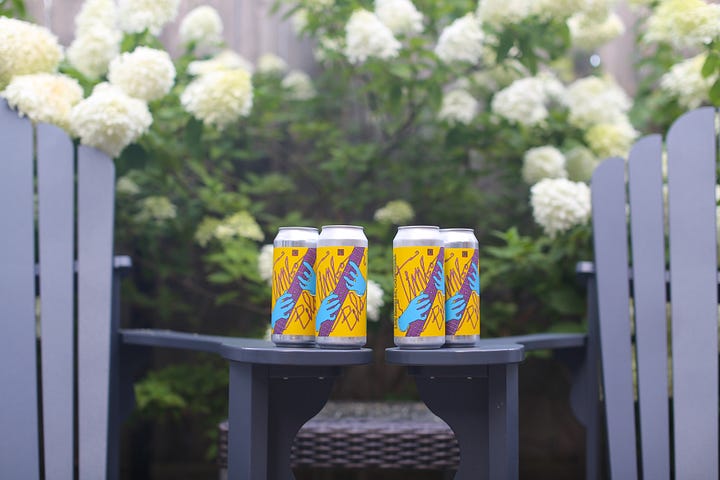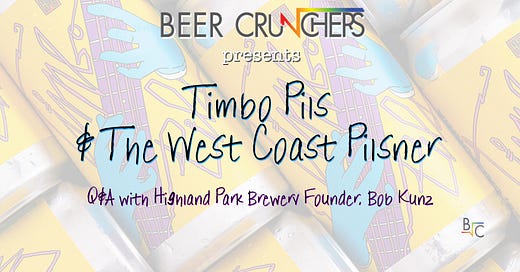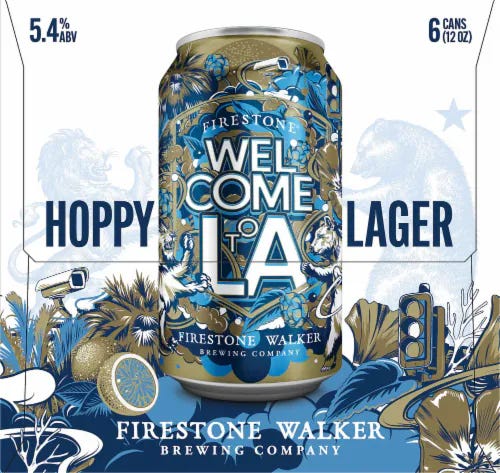Three Floyds’ Dark Lord Day started as a line for a sought-after beer that an entire festival was eventually built to surround. Named after their annual Imperial Stout release, the day grew into a phenomenon that drew craft beer enthusiasts from around the country. The festival's biggest hook eventually became the variants which innovated and experimented around the premise. Attendees would shell out big bucks to receive a randomly selected, wax-dipped bottle of a barrel-aged Dark Lord variant, which might be worth $400-600 on the dark web or instantly make you the star at your bottle share.
The craft beer enthusiast has evolved a lot over the past decade, along with what drives their excitement. As a result, some brewery strategies have shifted, while other aspects of this iconic event remain timeless.
Last week, beer fans in Southern California gathered at LA’s Highland Park Brewery (HPB) for a weeklong celebration of a style that didn’t even exist ten years ago: the West Coast Pilsner. At about 1/3 of the ABV% of Dark Lord, the West Coast Pilsner embodies the evolution of craft beer fans and culture since its peak as a hobby ten years ago. Unlike like Dark Lord Day, which is built on the premise of a specialty release designed for special occasions and bottle sharing, Timbo Week centers around HPB’s daily drinker Timbo Pils and its tagline “German tradition meets West Coast Flair!”
Crafted with German influenced hops for a soft bitterness and floral, earthy base, then dry-hopped with Mosaic and Citra for explosive tropical flavors of mango, riesling grapes, and passionfruit, Timbo Pils strikes the perfect balance. It offers the crispness of a pilsner and the hop intensity of an IPA, resulting in a uniquely refreshing brew that’s both fruity and crisp.
The timing of IPA cycling back toward West Coast IPAs this decade, combined with the emergence of craft beer’s final boss: Lager, has the West Coast Pilsner perfectly positioned to reunite all the divided craft beer fans. Like Dark Lord Day, Timbo was showcased with multiple variations released throughout the celebratory week, including unfiltered and double dry hopped versions, alongside events and collaborations:
As a long-time admirer of Highland Park’s reputation for quality, I was honored when their team reached out earlier this Summer for some hop water-related advice. Through that back-and-forth, founder Bob Kunz agreed to take on my questions about the creation, evolution, and current state of this intriguing hybrid of styles:
1. Similar to Social Kitchen with the Brut IPA and Wayfinder for the Cold IPA, from my vintage point Highland Park gets deserved credit for either creating or popularizing the West Coast Pilsner. Is that credit earned in your opinion? Do you feel you are properly credited for introducing the West Coast Pils? Does anyone else stake claim to the throne as well?
It seems like we were possibly the first to coin the term “West Coast Pils.” In 2015 or 2016 when we described Timbo as a West Coast Pils, the term was new to us. We simply were working toward combining a West Coast IPA and a German Style Pils and needed to define it somehow to communicate to customers what we were getting at. For us, it made sense because “West Coast” and “Pils” immediately evokes something for people. The goal was simply to let customers know what they were getting into. I think the idea of a modern, hop forward pils was sort of bubbling in the collective consciousness, but hadn’t really been defined yet. I think Timbo and West Coast Pils helped give the idea an anchor point.
2. What came first for Highland Park, the recipe for what is now Timbo or the style name “West Coast Pilsner”? In other words, did you create Timbo before you knew you’d be referring to it as a WC Pilsner or did the concept for the style come first then you designed the recipe to bring the idea to life?
Timbo definitely came first. We made a cask beer where we blended a WC IPA (Hello, LA) and a Pilsner (Refresh) and loved it. This pushed us to design a beer that combined those two recipes. We called the beer Timbo, but hadn’t identified a style yet. We then brainstormed terms to try and communicate to our customers what they were getting into. West Coast Pilsner is what we came up with.
3. What goes through your mind when you see a brewery announce a new West Coast Pils on social media or if you walk into a Taproom of a brewery you don’t have a personal relationship with? What do you hope they took into account or avoided?
It’s a little surreal at times seeing all the West Coast Pils out in the world. We typically try and stay focused on our product, keeping a constant state of improvement and innovation internally. So some times its really cool to take a step back and see what others are doing. It can be pretty mind boggling to see we helped get the wheels moving for innovation industry wide. As far as how other people approach the style, we tend to leave that up to them. I’m pretty anti-dogmatic as it relates to styles. For me they’re always evolving and changing and typically the really interesting and cool developments come through when people make something their own, suiting the tastes of themselves or their audience.
4. What elements of the Timbo recipe would you like to see other brewers keep intact when making a West Coast Pilsner of their own? What liberties are you okay with them taking to make the recipe their own, versus a clone of Timbo?
We’re happy people take liberties with the style! I mean if I had to answer this it would be that the beer is clearly hop forward with modern hops and that it has an ABV and palate experience that is highly drinkable.
5. Can you explain the extent to which Timbo has become the leader in the Highland Park portfolio and what it means to your business? What were some of its biggest milestones along the way? Is there a future milestone for Timbo that you aspire for?
Kind of piggy backing on one of the answers above, Timbo has kind of given us an anchor point. For so long we rotated through beers so heavily that it was only the die hard craft beer fans that we were reaching. At some point we realized at HPB that people need anchor points or familiarity to have a clear identification with a brand. Timbo was already beginning to make a name for itself, but probably 4-5 years ago we made a conscious decision to lean into it a little heavier. We felt like it really represented us and it is the type of beer we want to be making as a brewery. For me, Timbo is my favorite beer and the type of beer I want to drink all the time so it was pretty easy to lean into. For some reason all the things just sort of work, the name is fun to say, the shreddin’ guitar is silly and fun, the colors pop, its just fun. And then the beer sensory experience reflects these same things. It just all comes together. I’m pretty obsessive when it comes to making beer, but I think the beer drinking experience should be less about obsessiveness and more just about enjoyment. For me, Timbo kind of exudes this joyful consumer experience. ITS FUN!!
Timbo Week definitely helped give the beer more exposure. We started that 4 years ago I think. We asked a handful of brewery friends if they’d want to brew their version of Timbo and they all were pumped to jump on board. So now we have this week dedicated to Timbo where we make a bunch of fun variants and then our friends brew their versions and it’s a blast. It’s also pretty rad to have a beer event centered around a more sessionable beer AND your not tied to a day or time but can just come and have a good time throughout the week. Its great!
Lastly, its kind of funny that its become our “flagship” so to speak. For our customers that come into our taproom its such an easy sell as its identifiable with our brand as a whole. But as we’ve grown as a brewery and started doing a bit more wholesale around LA it can be a bit of a tougher sale. The term “West Coast Pils” is not fully in the collective consciousness yet, it’s a bit more specific to the craft beer insider. So it usually requires someone at our wholesale accounts buying into Timbo and evangelizing about it. Once they get it, they’re usually all in, but sometimes this can be tricky as a lot of our wholesale accounts just want the easiest sell.


A few weeks ago I lobbed this tweet onto Twitter and originally ended it with “like the West Coast Pilsner” but then decided to delete that part and let the tweet be more open-ended to see what would happen. Within minutes, someone read my mind:
The rise of the Hazy IPA surprised many long-established breweries with its unprecedented size, impact, and staying power, causing a wave of FOMO as the next trends emerged. When the Brut IPA showed up, too many jumped in way too fast and before it could be defined, leading to a swift and dramatic splat. To navigate future beer style evolutions successfully, a balanced approach is needed—somewhere in between these two extremes.
The West Coast Pilsner emerged organically, with Highland Park leading the charge and sharing the wealth. Each year, the brewery partners with friends in other markets to brew tribute batches of Timbo and host their own release celebrations. This approach avoids the frantic rush of chasing trends, focusing instead on genuine, sustainable growth. As Bob notes, there's still much work to be done to build awareness for this style. That reality will keep opportunists at bay and reinforces my belief in the West Coast Pilsner's permanence. Long live Timbo.








